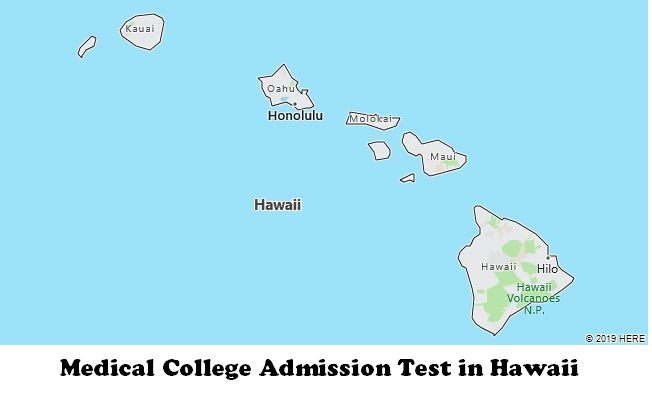According to AAMC (the MCAT test maker), there are 2 MCAT test centers in Hawaii. Most testing centers are located inside a college or university. You can select a testing location that is nearest to you. Please note that you are able to choose a test center when registering for the MCAT.

Honolulu – Nimitz Highway
1130 N NIMITZ HWY
Suite B297
HONOLULU, HI 96817
ETS – UNIV OF HAWAII/MANOA
2600 CAMPUS ROAD
Queen Lili’uokalani Center
for Student Services
ROOM 307
HONOLULU, HI 96822

The population of Hawaii
About 1,400,000 people live in the state of Hawaii (the fortieth most populous among the US states). The average population density in the state is about 83 people per km 2 (13th place in the USA).
The largest cities in Hawaii are the capital of the state of Honolulu located on the island of Oahu (more than 390,000 residents, forty-sixth place in the list of the largest cities in the USA), Pearl City (about 50,000 residents), Hilo (about 45,000 residents), Waipau (more than 38 000 residents) and Kano (about 35,000 residents). It should be noted that in the state of Hawaii, except for Honolulu, there are no cities in the usual sense for us – with self-government bodies, administrative boundaries, etc, therefore, when talking about other cities, we mean areas allocated by the US Census Bureau for statistical purposes.
All these cities, with the exception of Hilo, located on the island of Hawaii, form, together with other settlements, the Honolulu metropolis (or “Oahu metropolis”), in which about 980,000 people live (sixty-first place in the list of US metropolitan areas) – about 70% of the state’s population.
| Distribution of the population by the largest islands of the state of Hawaii | |||
| Island name | Population, people | Population density, people per km 2 | The largest settlement of the island and its population |
| Oahu | around 980,000 | about 635 | Honolulu, over 390,000 |
| Hawaii | about 190,000 | around 18 | Hilo, about 45,000 |
| Maui | about 145,000 | about 77 | Kahului, about 27,000 |
| Kauai | around 67,000 | about 47 | Kapaa, around 11,000 |
| Molokai | about 7 500 | around 11 | Kaunakakai, about 3,500 |
| Lanai | about 3 150 | around 9 | Lanai City, about 3,150 |
| Niihau | about 130 | about 0.7 | Puuai, about 130 |
A characteristic feature of Hawaii is that the vast majority of the state’s population is concentrated on the “capital” island of Oahu. It is interesting that the population density on it significantly exceeds that of the most populous US state – New Jersey (about 460 people per km 2).
The racial composition of the population of the state of Hawaii:
- White – 24.7%
- Blacks (African Americans) – 1.6%
- Asians – 38.6%
- Native Americans (Indians or Eskimos of Alaska) – 0.3%
- Native Hawaiian or Oceanian – 10.0%
- Other races – 1.2%
- Two or more races – 23.6%
- Hispanic or Latino (of any race) – 8.9%
Hawaii is one of four (along with California, New Mexico, and Texas) U.S. states where “the majority is the minority”. Fewer (in relation to the total population) people of the white race live here than in any other of the US states. Also here are the most Asians and their descendants, as well as representatives of “mixed” races.
The largest ethnic (national) groups among the population of Hawaii:
- Filipinos – 13.6%
- Japanese – 12.6%
- Polynesians (including Hawaiians) – 9.0%
- Germans – 7.4%
- Irish – 5.2%
- English – 4.6%
- Portuguese -4.3%
- Chinese – 4.1%
- Koreans – 3.1%
- Mexicans – 2.9%
- People from Puerto Rico – 2.8%
- Italians – 2.7%
- French – 1.7%
- Scots – 1.2%
Although only about 2,000 people speak Hawaiian, it is, along with English, the official language of the state of Hawaii.
The largest population groups in the state of Hawaii by religion:
- Christians – about 65%, including:
- Protestants – about 38%
- Catholics – about 23%
- The Church of Jesus Christ of Latter-day Saints (Mormons) – about 3.5%
- Jews – less than 1%
- Atheists – about 20%
In the state of Hawaii, traditional Hawaiian beliefs (hooponopono), Confucianism, Taoism, Hinduism, and other predominantly Eastern religions are also more or less common.
